Sustaining Community-School Relationships Around Shared Visions of Climate Justice and Science Teaching
Connected Science Learning September-October 2021 (Volume 3, Issue 5)
By David Segura, Daniel Morales-Doyle, Susan Nelson, Amy Levingston, and Karen Canales
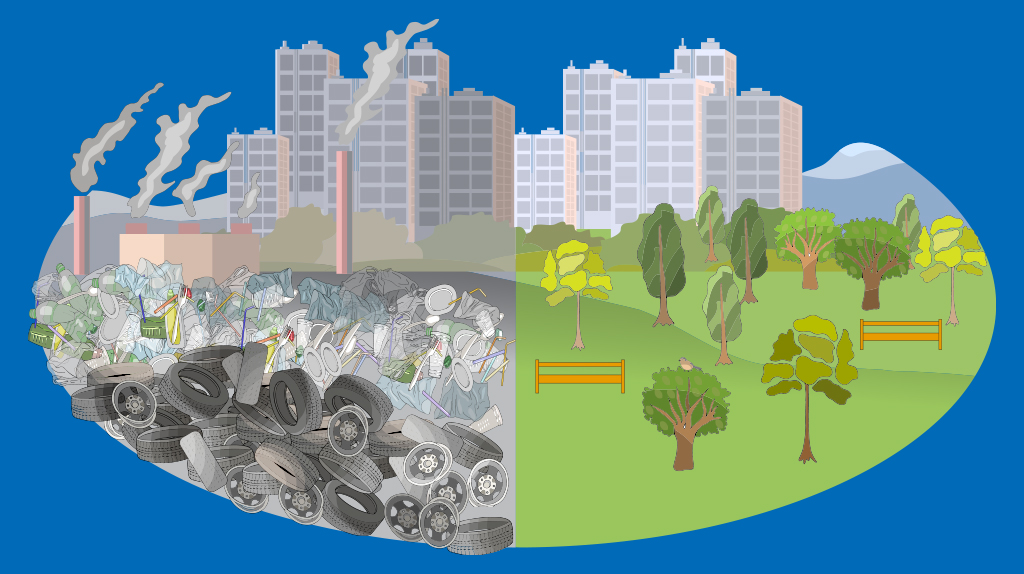
For the last 15 years, organizers from the Little Village Environmental Justice Organization (LVEJO) have been collaborating with science teachers from the Greater Lawndale Little Village High School for Social Justice (SOJO). These collaborations have sought ways to bring campaigns for environmental justice into the classroom while finding opportunities to bring science learning into the community. In this article we describe how our relationships have been reciprocal and sustainable over the years. We attribute this to a focus on holding expansive and principled visions of environmental justice through science teaching. We also explain a central assumption of our work: Youth from communities like North Lawndale and Little Village on the West Side of Chicago are important leaders in the intergenerational movement for a “just transition ... from an extractive economy to a regenerative economy” (Climate Justice Alliance, n.d.). We use examples from our collaborative work to illustrate key features and lessons from our attempts at community-based science learning for climate justice. For context, we share a brief history of the community-based organization and the school.
History of LVEJO
In 1994 a group of parents and community members from Gary Elementary School in Chicago’s Little Village neighborhood banded together to halt school repairs that were exposing summer school students to toxic fumes and particulates. These efforts coalesced into the formation of LVEJO, which is an organization that has been fighting environmental racism in the working class, predominantly Mexican immigrant community ever since. LVEJO’s theory of change is rooted in the belief that when people understand the root causes of their experiences of oppression, they have the power and agency to transform their world. Their campaigns have taken a broad view of environmental justice (EJ) and its intersections with other issues for justice ranging from access to public transit, immigration policy, and even police brutality and mass incarceration. The organization’s most widely celebrated victory was the 2012 closure of two coal-fired power plants on Chicago’s southwest side that had been grandfathered into exemptions from the Clean Air Act four decades prior. LVEJO is now the largest EJ organization in the midwestern United States.
History of SOJO
Prior to 2005 most students from Gary and other Little Village elementary schools attended the lone public high school in the neighborhood, just a few blocks from LVEJO’s office in the basement of a residential building. By the late 1990s the high school was in a crisis of overcrowding and underfunding. The state had allocated substantial funds to build a new high school in the neighborhood to alleviate this problem, but the mayor-controlled school district had done nothing with those funds even as two elite selective-enrollment high schools in affluent neighborhoods were built and opened in the same district, using allocations from the same timeframe.
After exhausting all sanctioned pathways to urge the district to build a new school in the neighborhood, 14 community members launched a hunger strike on Mother’s Day in 2001 to demand the construction of a new school. The hunger strike lasted for 19 long days before district and city officials finally heard the community’s demands for educational equity. An extensive process of negotiation, planning, and design followed, which involved substantial back-and-forth, collaboration, and compromise between district administrators, community members, educators, and even consultants and funders (see Stovall 2016). The outcome of that process was a plan for a high school campus, in the Little Village Industrial Corridor, to house four small high schools. These schools serve Little Village (officially known as South Lawndale) and North Lawndale, an adjacent predominantly African American neighborhood. The school’s placement in one of Chicago's 26 industrial corridors highlights the neighborhood’s lack of available land and the common challenges related to the selection of school sites in polluted areas (Mohai and Kweon 2020).
This process that founded the Little Village Lawndale High School Campus, which includes SOJO and the three other high schools, established distinct visions for each of the small schools on the campus. SOJO’s vision sought to continue the community-based activism embodied in the struggle to build the school. The visions of the other three schools include having access to high-quality STEM education, maintaining and celebrating multicultural arts, and world languages.
Sustainable Relationships Between Teachers and Organizers
LVEJO organizers and board members graciously worked with SOJO teachers as they learned about the current and historical EJ struggles within the community and worked to turn those issues into curriculum. LVEJO was an ideal partner as teachers tried to figure out how to take up this charge in the school science labs.
During the development and initial years of the school, curriculum design and teacher professional development was focused on treating three overlapping types of knowledge as equally important: classical, critical, and community knowledge (Gutstein 2006). Classical knowledge is what is typically valued in school curriculum. Critical knowledge emphasizes questioning the powers that be and critiquing the status quo. Community knowledge refers to the grassroots understandings of community members that exist outside of the purview of formal institutions of schooling. Working with LVEJO helped science teachers connect forms of community and critical knowledge developed by community members and EJ organizers with the classical science content they were charged with teaching.
The initial meetings between SOJO science teachers and LVEJO established a long-term relationship that continues. These relationships have been maintained by continuity and connections among the people who work in both the school and the organization. For example, one of the authors was a founding member of the science department who has continued in that role for the last 15 years. Another author is an alumna of the school who became an organizer with LVEJO, a position she has held for the last seven years. The other three authors have each spent at least seven years as full-time faculty at SOJO. One also served for a year on the LVEJO board. Furthermore, the executive director of LVEJO has been a leader in the organization and a vocal supporter of the school since the founding hunger strike.
The first meetings between teachers and LVEJO centered on the most visible symbol of pollution, a coal-fired power plant approximately a half mile from the school. Teachers developed curricula and projects focused on the coal power plant in all of SOJO’s science classes, including biology, chemistry, physics, environmental science, and advanced placement (AP) science classes. But the partnership has evolved and continued even after LVEJO members and their allies forced the power plant to close in 2012. This evolution has mirrored the continued struggles for environmental justice in the neighborhood. Both LVEJO organizers and SOJO teachers have worked together on multiple campaigns and curricula as new issues arose within the community. Mutual engagement and flexibility to take up new issues beyond the coal power plant has been a primary reason for the maintenance of this 15-year relationship.
Expansive and Principled Visions of Climate Justice
The continuing work between LVEJO and SOJO is built on an expansive view of climate justice, rooted in the shared belief that oppression is multi-faceted, interconnected, and deeply interwoven with social, political, and economic systems. With broader views of climate justice, our collaborations have occasionally connected directly to climate change while at other times the connection may only be apparent upon closer examination. Some LVEJO campaigns directly fought to curtail sources of carbon dioxide, like the struggle to close the coal power plant and multiple campaigns to prevent ever-increasing diesel truck traffic through the neighborhood. Others, like the push for more green space, wider access to public transportation, or reduction of volatile organic compounds (VOCs) in manufacturing processes are connected to the issue of climate change indirectly. In these cases classroom instruction facilitated students making connections (through science content learning) between local LVEJO campaigns and global issues of climate change. Our work together has also been predicated on an expansive view of science teaching where addressing social justice science issues supersedes the disciplinary boundaries that typically characterize biology, chemistry, or physics classes.
A particular example is an interdisciplinary sophomore capstone project that examines the role of capitalism in the extractive materials economy that is responsible for climate change and other environmental catastrophes. This capstone project draws on multiple content area classes to have students evaluate a consumer good that is important or relevant to them, examine and analyze its life cycle, and calculate the energy impact of its production and movement globally. This project also works to turn classroom instruction into real-world action. For example, with the assistance of LVEJO, students organized to be part of a climate march in the city center.
Taking a broader approach to both science teaching and understanding climate change also allows for an organized analytical approach for the complex interconnections related to climate justice. From a scientific point of view, students may learn that excess carbon dioxide caused by burning fossil fuels is the primary driver of carbon dioxide in the atmosphere. But an expansive view of student learning crosses disciplinary boundaries to deal with the ways that climate change is caused by extractive social, political, and economic systems predicated on the exploitation of human labor and the Earth. The interdisciplinary connections in this project include students learning about the history of exploitation of the Earth as rooted in colonialism, conquest, and genocide (Hill 2010; Rochlin 2012). At SOJO, science teachers consider these historical understandings as foundational to understanding environmental injustice related to climate change. This teaching is positioned as justice-centered and antiracist in its framing of white supremacy as justifying the exploitation of “undiscovered” lands and erasure of Indigenous people (Jacob et al. 2021).
Reciprocal Relationships Between the School and LVEJO
Mutual engagement was also maintained by reciprocity between LVEJO and SOJO when working on issues. This was strategically done in ways as identified by each other to draw on the strengths of LVEJO and SOJO respectively. LVEJOs established presence within the community, and its campaigns sought community input using door-to-door outreach, a level of community contact around science concerns that would be difficult for teachers to pursue. This is especially true in a small school where there are fewer faculty among whom to divide responsibility for committee work, outreach, and sponsoring of extracurricular activities.
The common goals of LVEJO and SOJO helped align classroom instruction with active opportunities for engagement among students while validating science curriculum as grounded in community-based environmental issues (Figure 1a and 1b). As teachers sought to design community-based, justice-centered science lessons, LVEJO provided access to an organization that was already engaged in direct actions to address the injustices faced by community members, modeling social justice that was the goal of the school. This narrowed the scope of teachers’ responsibilities to implementing instruction and supporting (not leading) the organizing, while still providing students with an outlet for acting on what they were learning. This mutual engagement provided opportunities for building capacity within the school that focused on community knowledge and connections. It also formed connections between LVEJO and students who were already engaged, knowledgeable, and motivated for action on community environmental issues while also leading to volunteer and employment opportunities for students (see Figure 2).
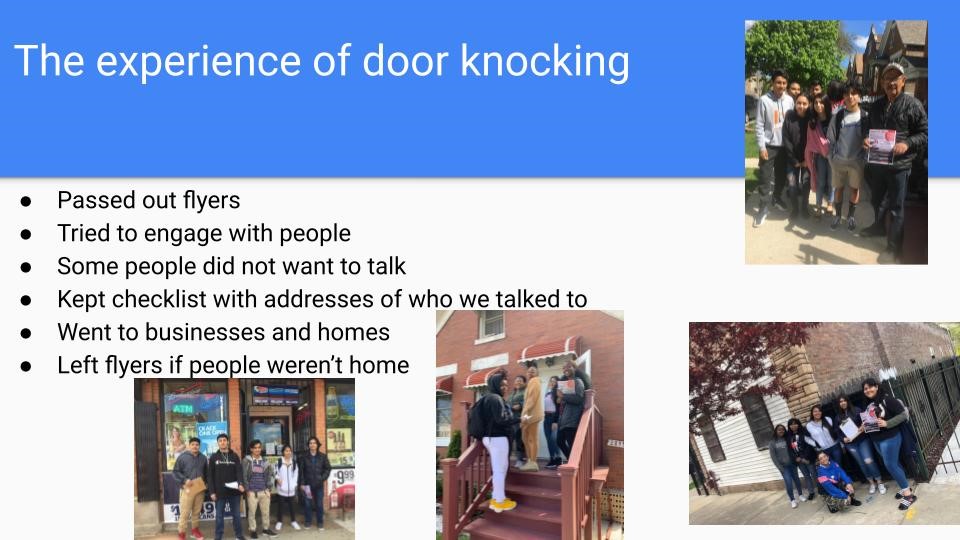
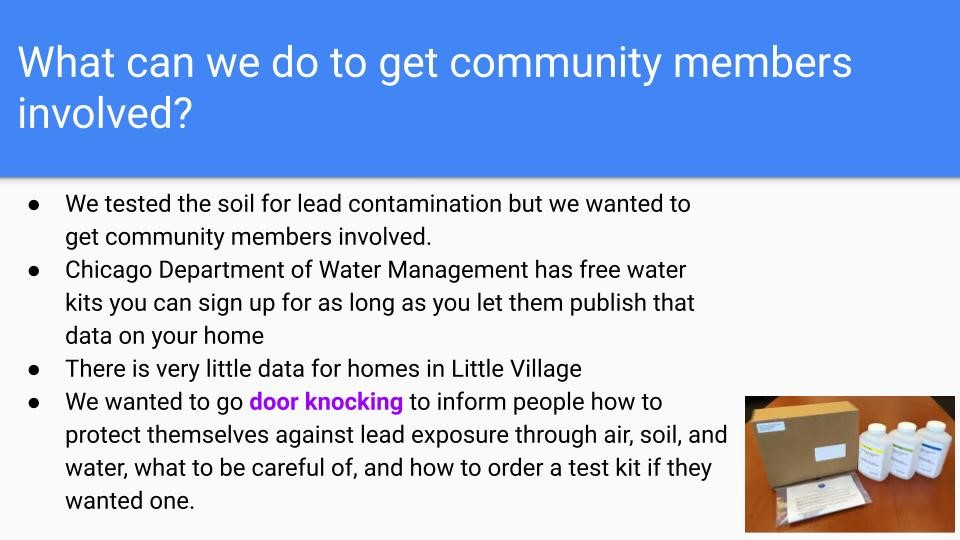
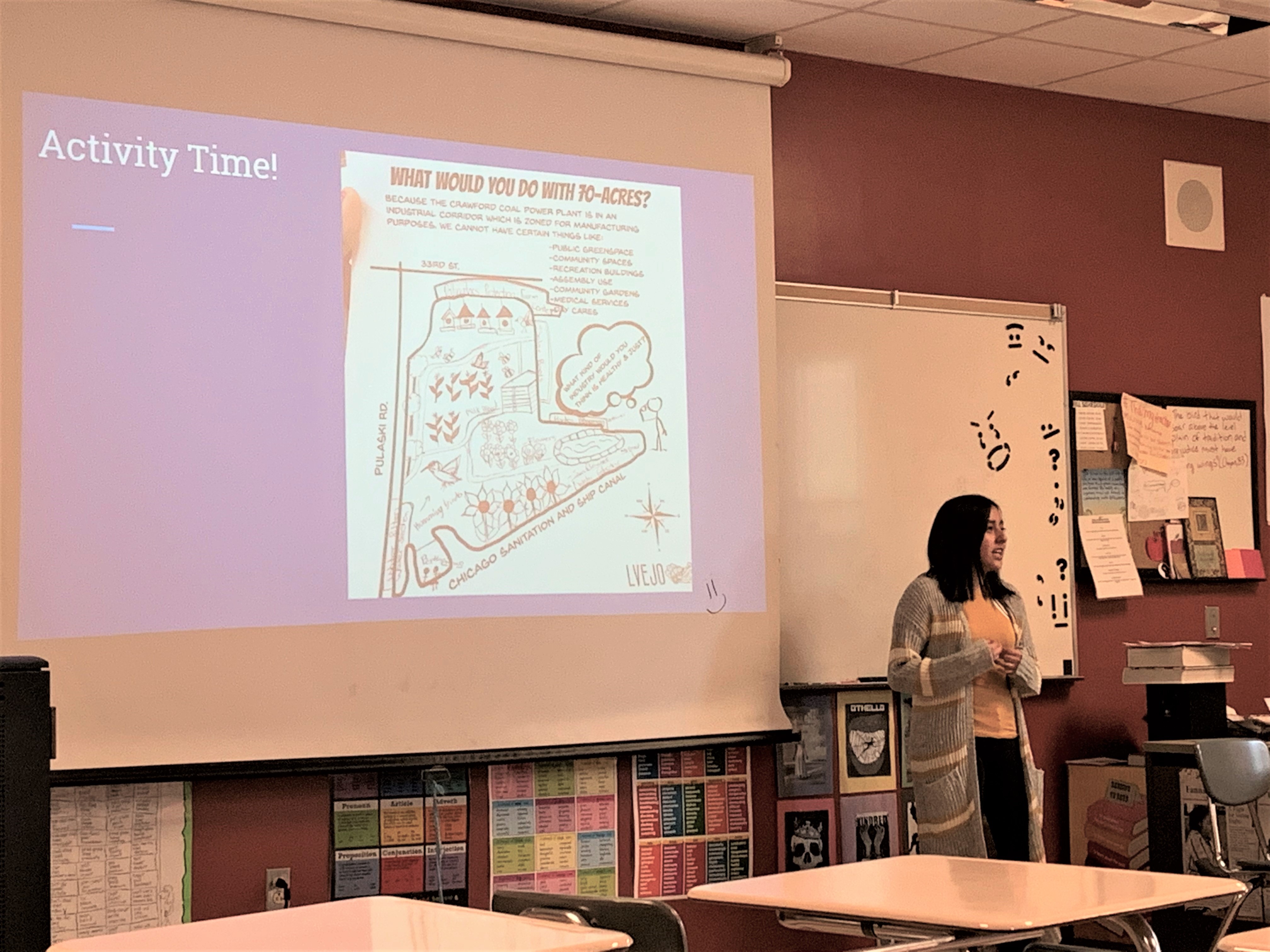
SOJO Teaching About LVEJO Campaigns
SOJO teachers have sought to support the work of LVEJO by designing curriculum that integrates the current and historic LVEJO campaigns. For example, in environmental science class students learn about a former Superfund site, the Celotex site, that LVEJO successfully helped pressure the EPA and city to convert into a 21.4-acre park. This case study was an example of the tensions between equity and accountability, grounded in science. Students learned about the environmentally persistent contaminants on site, polycyclic aromatic hydrocarbons, while balancing accountability for landowners and manufacturers of tar and roofing products who used the land over its history. Additionally, students applied earlier learning of life-cycle analysis to identify and explain how lax environmental regulations created conditions for the contamination of the land. They considered how this contamination was an artifact of inadequate waste management and was related to larger calls for sustainability often ignored in the manufacturing and waste disposal process. Lastly, students learned that knowing more about types of contamination and their consequences for public health is useful evidence in arguing for social change. This was the case with this former Superfund site as directly connecting health impacts on residents to site contamination and runoff kept continued pressure on elected officials and corporate landowners to act, albeit not with the expedience desired by community members.
While learning about environmental policy, students were tasked with identifying solutions while considering the social and political nature of the remediation process that had extended remediation talks across multiple decades. When this case study was initially included in the SOJO science curriculum, the owners of the site, the EPA, and community members had not yet reached an agreement about the adequacy of the remediation, which included a cap unapproved as appropriate by the EPA. The EPA later said the cap was adequate. Rather than causing students to be confused, these tensions lent urgency and relevance to students learning about the use of scientific evidence and community voice in public policy, environmental remediation, and urban planning. Students considered—in their science classes and in their neighborhood context—how topics like sustainability, persistence of environmental contaminants, erosion, runoff, the precautionary principle, and life-cycle analysis intersect with community power and the political nature of change. Teachers supported students to make connections between this case study and larger issues in land development, including the building of schools on toxic land and in industrial corridors, as had been the case with SOJO and some of its feeder elementary schools.
During this unit, LVEJO organizers supported teachers’ and students’ environmental concerns by providing resources and making connections. For example, LVEJO provided internship opportunities for students and acted as a resource to learn about the history of the site from the perspective of residents. Since this was one of LVEJO’s long-term campaigns, LVEJO not only had a rich knowledge upon which teachers could draw to familiarize themselves with the site (see Figure 3), it maintained a history of its own advocacy. For example, SOJO teachers showed an LVEJO-produced documentary (see Figure 4, 5, and 6) that tracked the trials and tribulations of 20 years of action, which lead to constructing a park on the site.
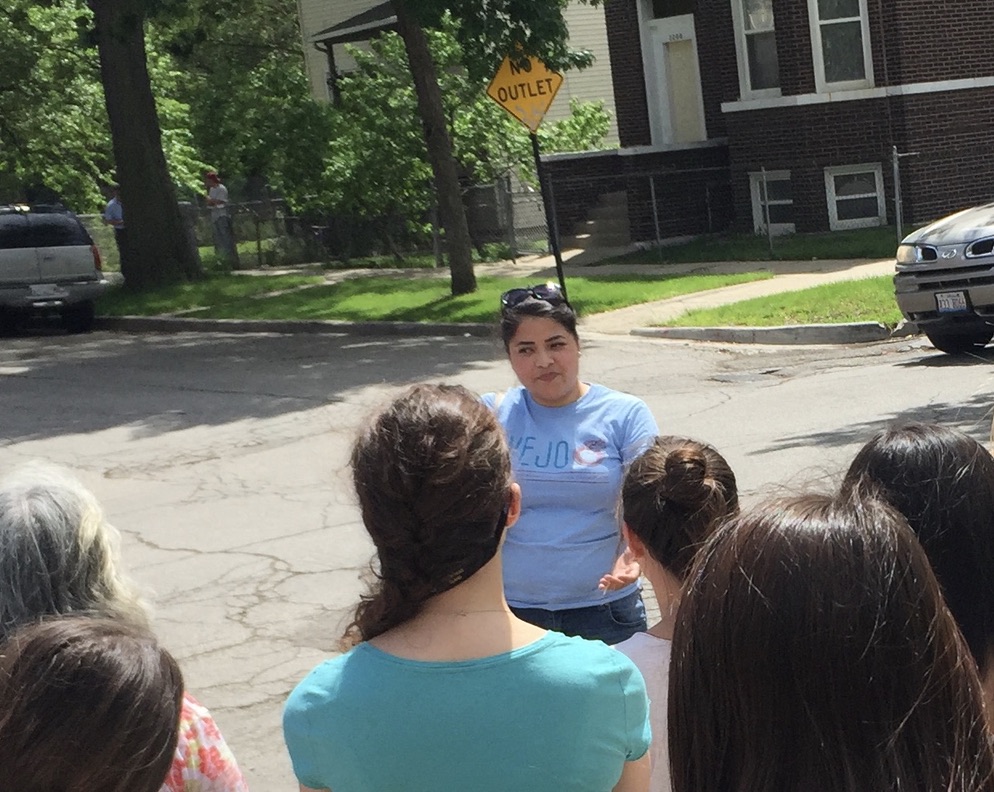


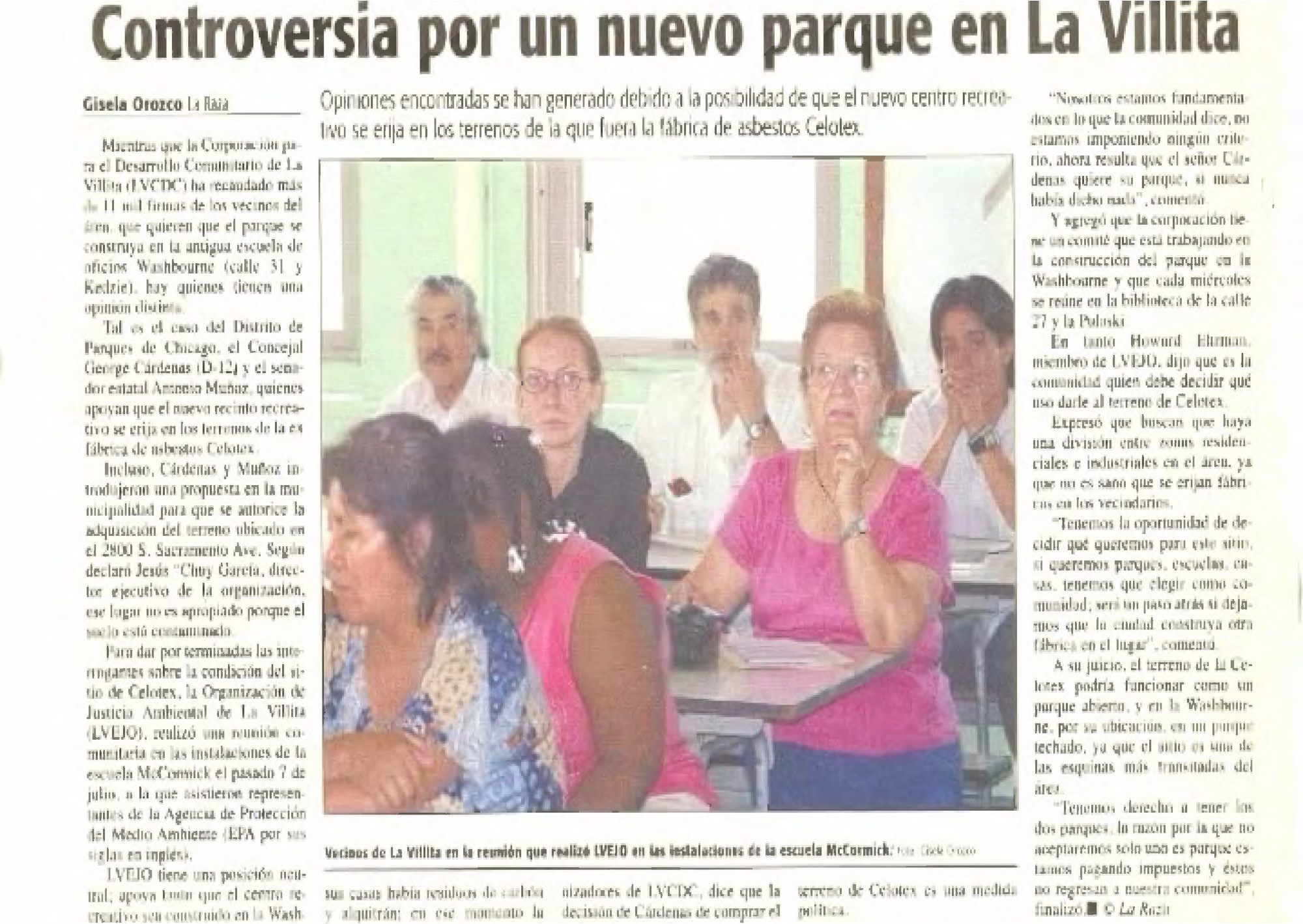
In chemistry, students have engaged in measuring and analyzing particulate matter and VOCs. This unit originated from LVEJO’s campaigns around the number of diesel trucks in the neighborhood. With the school and much of the neighborhood located in an industrial corridor, the development and expansion of Unilever’s Hellman’s Mayonnaise site, the demolition of the smokestack from the closed-down power plant (during the pandemic), and the construction of the distribution warehouse owned by HILCO, the increased truck traffic and overall air quality is a major community concern. These issues also display the ways in which the city exploits specific neighborhoods and places the burden on the people in those neighborhoods to provide proof that the environmental impacts residents experience are detrimental. This issue has served as an entry point to our study of spectroscopy and the instruments we use in chemical analysis—how they work and their limitations (Morales-Doyle, Childress Price, and Chappell 2019). We have also studied the biochemical ways that VOCs can impact long-term health. The unit has also provided an opportunity for students to design and carry out an experiment to measure the air quality within the school building.
Organizers from LVEJO have supported this work in the classroom with students when presenting their campaigns. These presentations have not only defined the problem and explained the health impacts of long-term exposure to particulate matter but have also provided the sociopolitical context that has created the overwhelming burden of pollution placed on Little Village. LVEJO’s engagement and lessons with youth also serve as a starting point for students to imagine what they want their neighborhood to look like. Students can use their scientific understandings to influence the decisions impacting their neighborhood. For example, after studying the health and biochemical impacts of particulate matter and VOCs, students wanted to advocate for rezoning the area around the school and other residential areas near industrial pollutants and diesel truck routes while continuing a more rigorous study of the air quality in the neighborhood.
LVEJO Supporting SOJO Youth Participatory Science Projects
One of the primary forms of engagement between SOJO and LVEJO through the years has been through youth participatory science (YPS; Morales-Doyle and Frausto 2021). YPS projects position students as experts by engaging them in data collection and analysis of the air they are breathing or the soil in the neighborhood. In a unit designed around analyzing the contaminants in the microclimate around the school, LVEJO loaned air monitors to students (see Figure 7) so they could experience real-time collection of particulate matter data. LVEJO youth interns spent a week showing students how to use the instruments to collect data throughout the day. This first collaboration was spurred by an LVEJO project involving community science and air quality data collection.
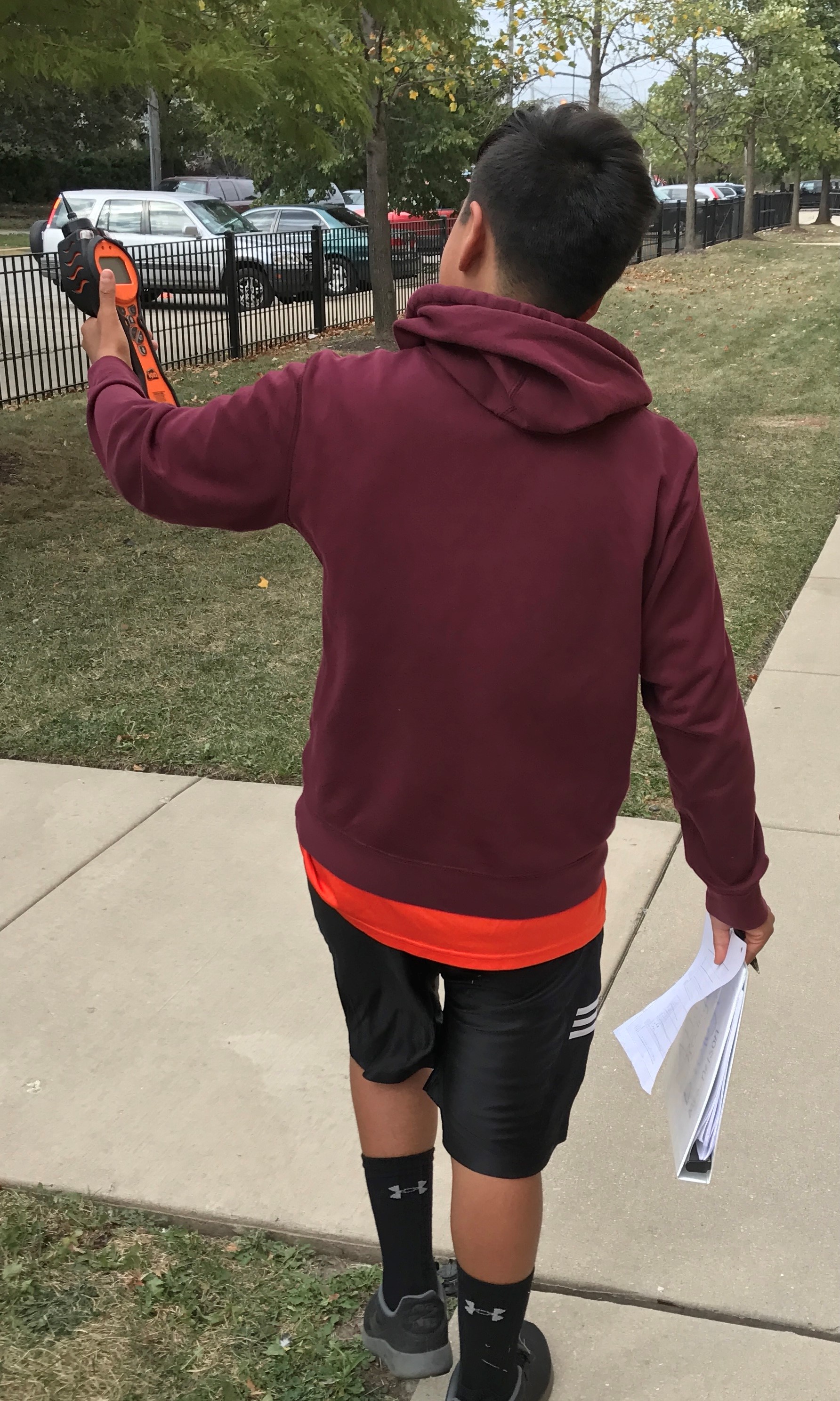
While students may not have contributed a substantial amount of data collection in the larger scheme of the project, LVEJO organizers viewed students experiencing this sort of community-engaged science as part of their work. Teachers and organizers believed that allowing students to see what they already instinctively knew about the air around them, but in a scientific context, was a powerful learning experience. This provided an entry point for students to become passionate about using their knowledge to change the situation. A few years later, a SOJO teacher reached out to LVEJO for technical support regarding data collection about VOCs. For years, students and staff at SOJO had complained about a chemical smell around the school. While LVEJO was not leading a VOCs campaign at the time, they nonetheless offered time and resources to support students in examining the smell.
LVEJO has continued to respond to the needs and desires of the students and school community. Over the past several years in chemistry class, students have been studying heavy metal contamination in soil and water, focusing on lead. With a university partner, students have collected soil and water samples from around the community that were analyzed for lead levels. Many of these samples contained lead levels above the EPA action limits of 15 parts per billion (ppb) for water, and 400 parts per million (ppm) for soil in play areas. Students wanted to respond to the issue in multiple ways—one of which was to inform community members through a door knocking campaign and give them access to sign up for free water testing through a citywide program. At the time, lead contamination in soil and water was not one of LVEJO’s campaigns, but they supported this work in several ways. Their support included designing and implementing a lesson on organizing and door knocking in sophomore civics class and helping students create flyers (see Figure 8). LVEJO organizers co-planned and accompanied students on their door-knocking campaign and facilitated a reflection on the experience afterward. Furthermore, they offered financial support for the printing of flyers, home water filters, while also providing connections to healthcare (if necessary) for any community members who had found high levels of lead in their test results.

The type of expertise that LVEJO community organizers bring into the classroom is invaluable to a teacher wanting to do this work with students, especially when it may not fit into even an expansively conceived science curriculum. These experiences can often propel teachers and students to become more comfortable and capable in civic participation around science issues (see Figure 9). Heavy metal contamination is tangentially connected to climate change: Heavy metal pollutants are emitted by burning coal and other especially dirty fossil fuels, and mercury is often released when permafrost melts (Schaefer et al. 2020; Schuster et al. 2018). But even more important than the scientific connection, these parts of our collaboration have been important for cultivating youth involvement in the struggle for climate justice and a just transition (see Figure 10).
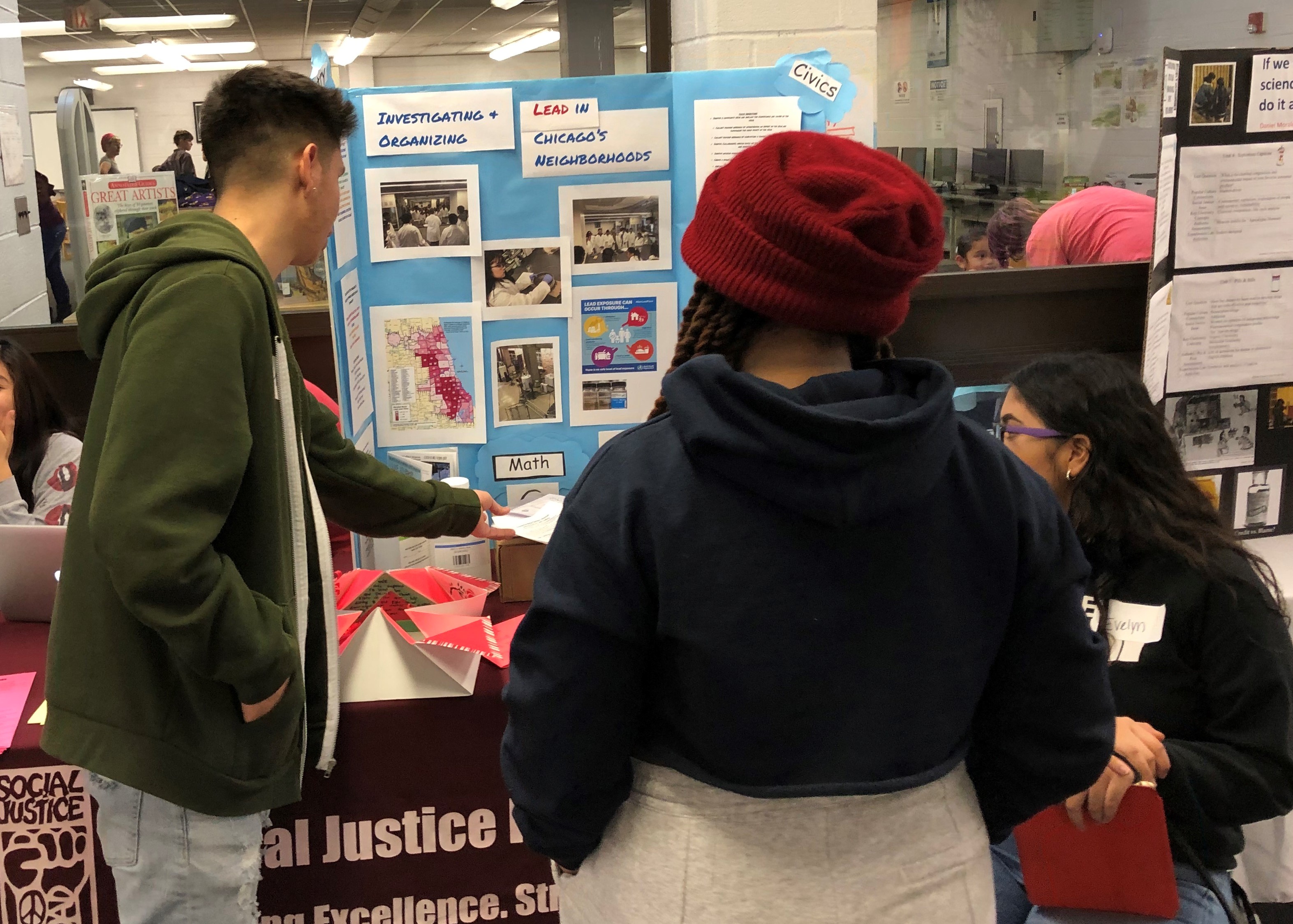
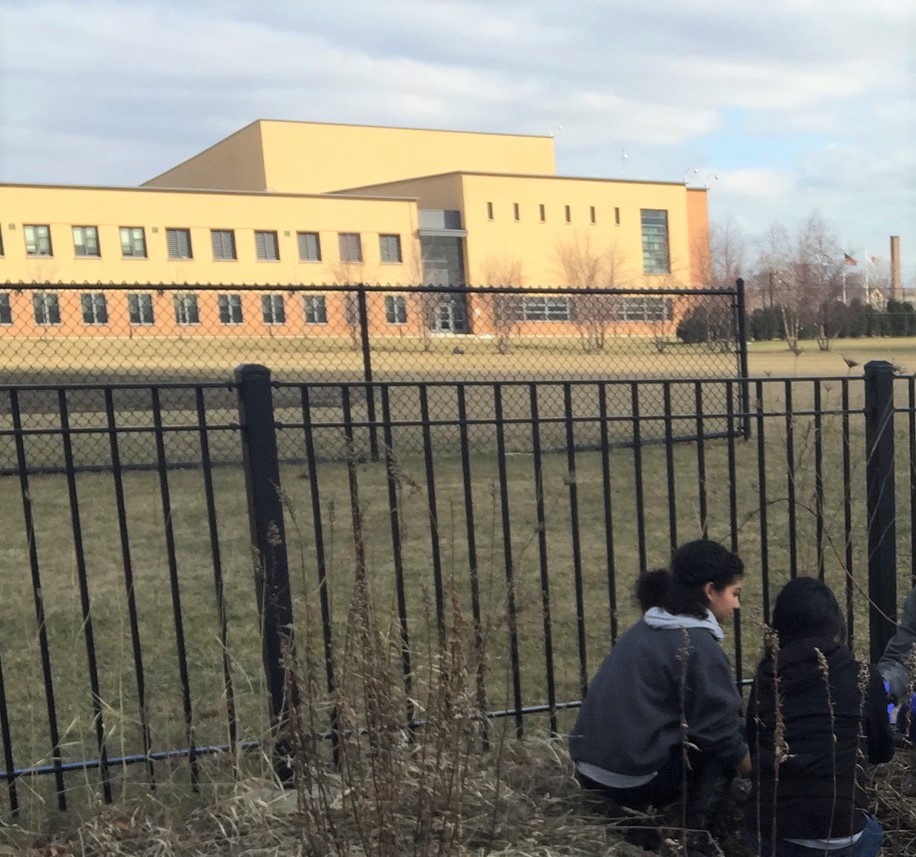
Navigating Conflicting Perspectives/Disagreements
While LVEJO and SOJO’s views of climate justice were aligned, there are always varied perspectives of justice within any community. In one example, an LVEJO campaign sought to block the expansion of Unilever, a multinational consumer goods company that has been manufacturing Hellmann’s Mayonnaise for over 100 years. Unilever’s expansion meant many of the diesel-powered vehicles would drive directly behind a local K–8 school, one of SOJO’s feeder schools. To alleviate community resistance to this project, Unilever offered the elementary school 2.5 acres of land to both expand their campus and add a community playground and gardening space. The space was much needed as the school was so overcrowded that they were borrowing classroom space from an old Catholic school a block away. Plans for the playground and gardening space were quickly revoked after community members voiced their concerns of the proximity to heavy-duty diesel vehicles. However, plans for the expansion of the campus continued in order to address the overcrowding issue this school faced. This highlighted the tensions that exist, where campaign “losses” or “wins” do not exist, but instead differing groups are impacted to a greater or lesser extent by controversial compromises. Similar outcomes have come from other campaigns. For example, when the coal power plant was closed, there was no promised remediation of the site, which has since become a giant warehouse in spite of LVEJOs organized objections. In the case of La Villita Park built on the Celotex site, we discussed the controversy about whether the EPA would approve the two-foot gravel and clay cap under the park that contained the contamination in the soil below ground level (EPA 2016).
Occasionally, SOJO and LVEJO have also had diverging ideas about how to best address community issues through the school. This is to be expected as the school and LVEJO share many goals but are not the same entity. In one case, teachers applied for funding from a large nonprofit organization for a community garden at the school. LVEJO organizers had concerns about the large nonprofit’s lack of community knowledge and potential ties to corporate partnerships. LVEJO has a vibrant community garden of its own, but it is too far from the school for students to readily access during class time. Teachers agreed with LVEJO’s critique of the funder but saw a strategic opportunity to meet a long-existing goal with minimal risk of co-optation or interference by the funder. In the end, SOJO and LVEJO worked together through opposition to analyze the best location for the garden. The garden has created an opportunity for students to take action regarding healthy food access, nurturing their ability to grow food, while drawing upon community and ancestral agricultural knowledge. Teachers also make connections with other YPS projects through conversations about raised beds and soil contamination in the community. The complexities of politics within the city and community—and even between LVEJO and SOJO—sometimes lead to competing views of what should be done to address inequity and where environmental issues fit within community priorities and politics. We view students, teachers, and organizers grappling with these complexities together as an invaluable source of learning about the potential role of scientific evidence in movements for climate and environmental justice.
Youth in EJ Communities as Leaders of an Intergenerational Just Transition
The campaigns waged by LVEJO have been focused on the self-determination of the Little Village community that has suffered the ill-effects of living in the midst of an industrial corridor where the expediency of business interests has been prioritized above the well-being of people and ecosystems. We believe that it is precisely this type of grassroots organizing by marginalized communities that has the power to spearhead a just transition that allows life to thrive through and beyond the climate crisis. While focusing in their backyard, LVEJO has taken an abolitionist approach, rather than a not-in-my-backyard (NIMBY) approach to their advocacy. For example, community members supported the capping of the Celotex Superfund site below La Villita Park because they did not want to ship the toxic soil into another marginalized community for disposal.
Within the context of partnership with LVEJO, science courses at SOJO have eschewed traditional notions of scientific literacy and STEM pipeline pedagogies in favor of prioritizing the development of active community members and students. This has helped encourage students develop perspectives of justice and sustainability as purposes to pursue STEM pathways rather than prioritizing personal or national economic gain or national defense (Valladares 2021).
David Segura (segurad@beloit.edu) is an Assistant Professor of Education and Youth Studies at Beloit College in Beloit, Wisconsin. Daniel Morales-Doyle is an Associate Professor of Curriculum and Instruction at the University of Illinois Chicago in Chicago, Illinois. Susan Nelson is a science teacher at Greater Lawndale Little Village High School for Social Justice in Chicago, Illinois. Amy Levingston is a science teacher and science department chair at Greater Lawndale Little Village High School for Social Justice in Chicago, Illinois. Karen Canales is the Environmental Justice Education Coordinator at the Little Village Environmental Justice Organization in Chicago, Illinois.
citation: Segura, D., D. Morales-Doyle, S. Nelson, A. Levingston, and K. Canales. 2021. Sustaining community-school relationships around shared visions of climate justice and science teaching. Connected Science Learning 3 (5). https://www.nsta.org/connected-science-learning/connected-science-learning-september-october-2021/sustaining-community
Advocacy Climate Change Equity Interdisciplinary High School Informal Education


